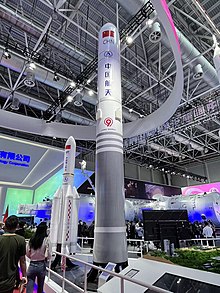
Back لونغ مارش 9 Arabic Langer Marsch 9 German Larga Marcha 9 Spanish Longue Marche 9 French Long March 9 ID Lunga Marcia 9 Italian 長征9号 Japanese 창정 9호 Korean Chang Zheng 9 Polish Чанчжэн-9 Russian
 Mock-up of the Long March 9 rocket at the 2022 Zhuhai Airshow | |
| Function | Super heavy-lift launch vehicle |
|---|---|
| Manufacturer | China Academy of Launch Vehicle Technology |
| Country of origin | |
| Size | |
| Height | 114 m (374 ft) |
| Diameter | 10.6 m (35 ft) |
| Mass | 4,369,000 kg (9,632,000 lb) |
| Stages | 3 |
| Capacity | |
| Payload to Low Earth orbit | |
| Mass | 150,000 kg (330,000 lb) |
| Payload to Trans-lunar injection | |
| Mass | 54,000 kg (119,000 lb) |
| Payload to Trans-martian injection | |
| Mass | 44,000 kg (97,000 lb) |
| Associated rockets | |
| Family | Long March (rocket family) |
| Comparable |
|
| Launch history | |
| Status | In development |
| First stage | |
| Diameter | 10.6 m (35 ft) |
| Propellant mass | 3,420,000 kg (7,540,000 lb) |
| Powered by | 30 YF-215 |
| Maximum thrust | 60 MN (13,000,000 lbf) |
| Specific impulse | 330 s (3.2 km/s) |
| Propellant | CH4 / LOX |
| Second stage | |
| Diameter | 10.6 m (35 ft) |
| Propellant mass | 370,000 kg (820,000 lb) |
| Powered by | 2 YF-215 |
| Maximum thrust | ~4.4 MN (990,000 lbf) |
| Specific impulse | ~363 s (3.56 km/s) |
| Propellant | CH4 / LOX |
| Third stage (Non-LEO version) | |
| Diameter | 10.6 m (35 ft) |
| Propellant mass | 140,000 kg (310,000 lb) |
| Powered by | 4 YF-79 |
| Maximum thrust | 1.0 MN (220,000 lbf) |
| Specific impulse | 455.2 s (4.464 km/s) |
| Propellant | LH2 / LOX |
Long March 9 (Chinese: 长征九号火箭, LM-9 or Changzheng 9, CZ-9) is a Chinese super-heavy carrier rocket that is currently under development.[1][2] It is the ninth iteration of the Long March rocket family, named for the Chinese Red Army's 1934–35 Long March campaign during the Chinese Civil War.
Current plans call for the Long March 9 to have a maximum payload capacity of 150,000 kg to low Earth orbit (LEO) and 54,000 kg to trans-lunar injection.[3][4] Its first flight is planned for 2033,[5] in anticipation of an increase in cadence by China's crewed lunar missions during the 2030s.[6][2] (As of 2023, the first crewed lunar landing attempt by China is expected to occur by the year 2030; this initial effort would use the under-development Long March 10 carrier rocket, the new Mengzhou crewed spacecraft, and the Lanyue crewed lunar lander.[7])
- ^ Jones, Andrew (5 July 2018). "China reveals details for super-heavy-lift Long March 9 and reusable Long March 8 rockets". SpaceNews. Archived from the original on 12 March 2023. Retrieved 1 March 2021.
- ^ a b Berger, Eric (24 February 2021). "China officially plans to move ahead with super-heavy Long March 9 rocket". Ars Technica. Archived from the original on 28 February 2021. Retrieved 1 March 2021.
- ^ Adrian Beil (2023-03-03). "Starship debut leading the rocket industry toward full reusability". NASASpaceflight.com. Archived from the original on 2023-03-10. Retrieved 2023-03-05.
- ^ "箭指载人登月!长征十号安排上了" (in Chinese (China)). China Aerospace Science and Technology Corporation. 2023-03-04. Archived from the original on 2023-08-05. Retrieved 2023-03-05.
- ^ Cite error: The named reference
NSF20230427was invoked but never defined (see the help page). - ^ Jones, Andrew (9 November 2022). "China scraps expendable Long March 9 rocket plan in favor of reusable version". SpaceNews. Archived from the original on 7 September 2023. Retrieved 18 November 2022.
- ^ Andrew Jones (17 July 2023). "China sets out preliminary crewed lunar landing plan". spacenews.com. Archived from the original on 8 February 2024. Retrieved 31 October 2023.